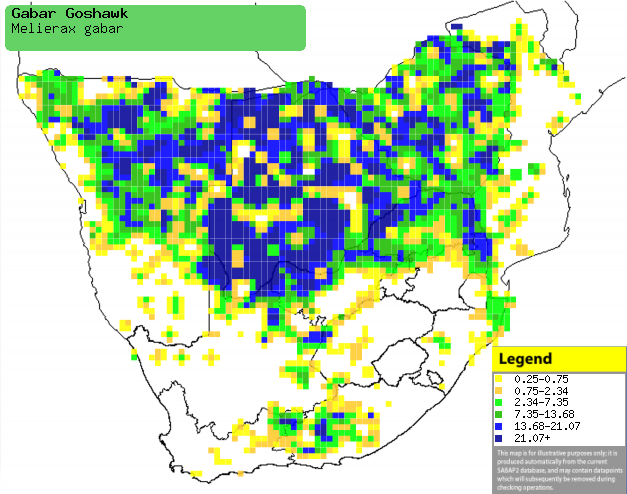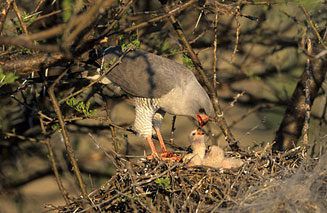|
Melierax gabar (Gabar
goshawk)
[= Micronisus gabar]
Witkruissperwer (Kleinsingvalk) [Afrikaans]; Mamphoko
[South Sotho]; Rukodzi (generic name for a small raptor such as falcon or
sparrowhawk) [Shona]; Lohheyane (generic term for small hawks) [Swazi];
Xikwhezana [Tsonga]; Phakalane, Segōōtsane (generic terms for some of
the smaller raptors) [Tswana]; Gabarhavik [Dutch]; Autour gabar [French];
Gabarhabicht [German]; Gavićo-palrador [Portuguese]
Life
> Eukaryotes >
Opisthokonta
> Metazoa (animals) >
Bilateria >
Deuterostomia > Chordata >
Craniata > Vertebrata (vertebrates) > Gnathostomata (jawed
vertebrates) > Teleostomi (teleost fish) > Osteichthyes (bony fish) > Class:
Sarcopterygii (lobe-finned
fish) > Stegocephalia (terrestrial
vertebrates) > Tetrapoda
(four-legged vertebrates) > Reptiliomorpha > Amniota >
Reptilia (reptiles) >
Romeriida > Diapsida > Archosauromorpha > Archosauria >
Dinosauria
(dinosaurs) > Saurischia > Theropoda (bipedal predatory dinosaurs) >
Coelurosauria > Maniraptora > Aves
(birds) > Order: Falconiformes
> Family: Accipitridae
> Genus: Melierax
Distribution and habitat
Occurs across sub-Saharan Africa, excluding the lowland forest
of the DRC and West Africa. In southern Africa, it is scarce to locally common
in Namibia,
Botswana, Zimbabwe, western Mozambique and South Africa. It generally prefers open woodland, especially dry
Acacia savanna and broad-leaved woodland, with miombo (Brachystegia),
cluster-leaf (Terminalia) and Mopane (Colosphermum mopane). In the
arid Karoo and Namib Desert, it is generally restricted to tree-lined
watercourses, but it may also move into cities and towns.
|
 |
|
Distribution of Gabar goshawk in southern Africa,
based on statistical smoothing of the records from first SA Bird Atlas
Project (©
Animal Demography unit, University of
Cape Town; smoothing by Birgit Erni and Francesca Little). Colours range
from dark blue (most common) through to yellow (least common).
See here for the latest distribution
from the SABAP2. |
Predators and parasites
Movements and migrations
Mainly sedentary, although it may aggregate in
the Kruger National Park from March-July.
Food
It mainly eats birds, using a hunting technique it mounts a perch concealed by vegetation.
From this vantage point it can spot prey, which it then hawks aerially or
ambushes on the ground; it often
pursues prey over great distances. It regularly eats nestlings,
ripping open nests with its beak and grabbing chicks from within. The following food items have been recorded
in its diet:
- Birds
- Mammals
- Reptiles
- Insects
Breeding
- Monogamous, territorial solitary nester, performing a courtship display in
which the breeding pair chase each other through the trees.
- The nest (see image below) is built mainly or solely by the female in
roughly 2-6 weeks, consisting of a cup of sticks lined with grass, earth,
dry leaves, lichen, spider's web, sheep's wool,
penduline-tit nests,
feathers and rags, while the exterior is decorated with spider web. It is
typically placed in an indigenous tree, such as the following:
- indigenous
- Acacia
- A. nigrescens (Knob thorn)
- A. tortilis (Umbrella thorn)
- A. erioloba (Camel thorn)
- A. galpinii (Monkey acacia)
- A. luederitzii (Kalahari-sand acacia)
- A. reficiens (Red umbrella thorn)
- A. burkei (Black monkey thorn)
- Faidherbia albida (Ana-tree)
- Combretum imberbe (Leadwood)
- Colosphermum mopane (Mopane)
- Terminalia sericea (Silver cluster-leaf)
- Terminalia prunioides (Purple-pod cluster-leaf)
- Commiphora pyracanthoides (Firethorn corkwood)
- Brachystegia spiciformis (Musasa)
- Burkea africana (Burkea)
- alien
- Pinus (pines)
- Populus (poplars)
- Schinus molle (Pepper-tree)
 |
|
|
Gabar goshawk feeding its chicks, Nylsvley area,
South Africa. [photo Warwick Tarboton ©] |
|
- Egg-laying season is from July-December, peaking from September-November.
- It lays 2-4 eggs, which are mainly incubated by the female for about
33-38 days.
- The chicks are are brooded by the female for the first 19-21 days of
their lives, while the male gives her food to feed to them. The young leave the
nest at about 35-36 days old, becoming fully independent at least one month
later.
Threats
Not threatened.
References
-
Hockey PAR, Dean WRJ and Ryan PG 2005. Roberts
- Birds of southern Africa, VIIth ed. The Trustees of the John Voelcker
Bird Book Fund, Cape Town.
|
